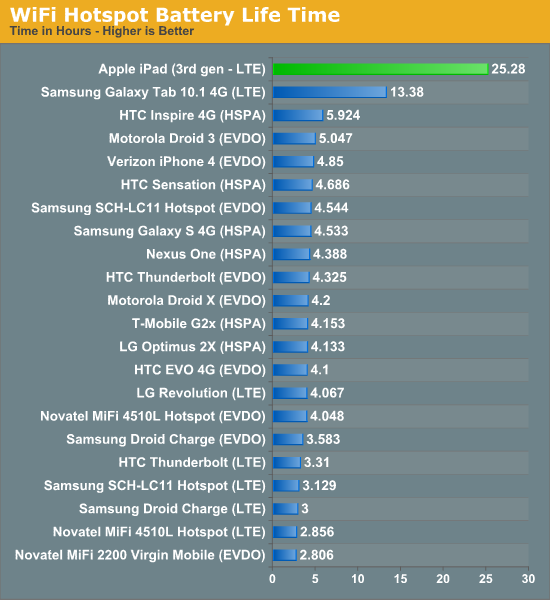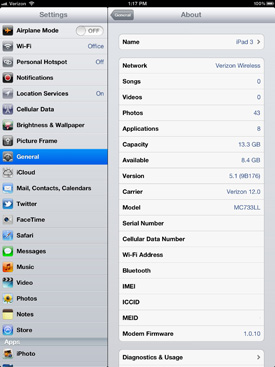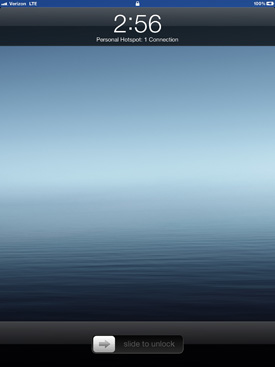The Apple iPad Review (2012)
by Vivek Gowri & Anand Lal Shimpi on March 28, 2012 3:14 PM ESTThe iPad as a Personal Hotspot: Over 25 Hours of Continuous Use
Verizon makes the decision of which iPad to buy even more difficult by being the only of the two US carriers to enable the personal hotspot option on the new iPad. For no additional monthly fee on top of your data plan your Verizon LTE iPad can act as a wireless hotspot, allowing up to five other devices to use its cellular connection over WiFi (2.4GHz only, unfortunately) or Bluetooth. One device can use the hotspot via the iPad's USB dock cable.
If you don't already have the personal hotspot option in the initial settings page, you'll need to go to general settings, then network, and activate personal hotspot there. Once you've done so you'll see a new item for personal hotspot in the default settings page.
You must remain on the personal hotspot settings page for the iPad's SSID to be visible to nearby devices. Once you leave the settings page, the iPad stops broadcasting its personal hotspot SSID.
In general the iPad's personal hotspot seems to be better behaved than similar options under Android. I've noticed all too often that Android hotspots will either stop routing traffic after an extended period of use, requiring either cycling the radio states on the hotspot device itself or in some cases a full reset of the hardware. The iPad wasn't immune to this sort of behavior, it just seemed to happen less than on the Android tablets and smartphones that I've tested. In one test it took only a few hours before I had to reset the iPad to make its hotspot work properly again, while in another case it was only after 24 hours of continuous use that the feature began misbehaving. Overall I am very pleased with the Verizon iPad as a personal hotspot, the bigger issue is the cost of the data that you're sharing with all of those devices.
As I mentioned in our Galaxy Tab 10.1 LTE review, these LTE tablets make great hotspots simply because you are pairing smartphone modems with gigantic (for a smartphone) batteries. The end result is if you have to treat your LTE tablet as a true hotspot (screen off and all), you get great battery life. The new iPad takes this idea to a completely new level since its battery is now squarely in the laptop-sized category, but its LTE modem is still designed to run on a < 6Wh smartphone battery.
Our standard hotspot battery life test involves running four copies of our web browsing battery life test and playing a 128Kbps internet radio stream on a laptop tethered via WiFi to the hotspot being tested. While peak download speeds during this test can reach as high as 1MB/s, remember that these web browsing battery life scripts include significant idle time to simulate reading a web page. The average data transferred over the duration of the test amounts to around 25KB/s if you take into account idle periods.
With the Galaxy Tab 10.1 LTE I tried something different—letting the tethered notebook download at full speed using the Tab's LTE connection. On the new iPad, after nearly an hour of downloads at well over 1MB/s I saw no drop in the battery percentage indicator—it was stuck at 100%. Not wanting to upset Verizon too much, I needed to find a good balance between a realistic workload and something that wasn't going to make me rack up over a hundred GB in overages.
If our standard hotspot test averages around 25KB/s of transfers, I figured doubling it couldn't hurt. I downloaded a sufficiently large file at a constant 50KB/s on a laptop tethered over WiFi to the new iPad to see how long it would last. The result was astounding: 25.3 hours on a single charge

I used up over 4.5GB during this period—almost the entire amount that my $50/month plan gave me, all without having to plug the iPad in to recharge it. That's the beauty of using a 42.5Wh battery to drive a cellular modem that can last a couple of hours on a tenth of that capacity. If you want to use the new iPad as a personal hotspot, you'll likely run out of data before you run out of battery life.
It's a real shame that AT&T decided against enabling personal hotspot on its version of the LTE iPad. It's for this reason alone that I'd recommend the Verizon version, assuming that you're planning on using your iPad in an area where Verizon has LTE coverage of course.












234 Comments
View All Comments
Steelbom - Thursday, March 29, 2012 - link
I'm curious why we didn't see any graphics benchmarks from the UDK like with the iPhone 4S review?Craig234 - Thursday, March 29, 2012 - link
Wow, this is good to buy... 'if you are in desperate need for a tablet'?That's a pretty weak recommendation, I expected a much stronger endorsement based on the review.
Chaki Shante - Friday, March 30, 2012 - link
Great, thorough review, thanks Anand et al.Given the sheer size of the SoC (like 4x larger then Tegra2 or OMAP4430, and 2x Tegra3), you'd bet Apple has the fastest current SoC, at least GPU-wise.
This SoC is just huge and Apple's margin is certainly lowered. Is this sustainable on the long run ?
I wonder if any other silicon manufacturer could make same size devices (not technologically but from a price perspective) and expect to sell them.
dagamer34 - Friday, March 30, 2012 - link
No one else needs to crank out so many chips that are the same. Also, other companies will be waiting long enough to use 28nm, so there's little chance they'll be hitting the same size as the A5X on 45nm.Aenean144 - Friday, March 30, 2012 - link
Since Apple is both the chip designer/licensee and hardware vendor, it saves them the cost of paying a middleman. Ie, Nvidia has to make a profit on a Tegra sale, Apple does not, and can afford a more expensive chip from the fab compared to the business component chain from Asus to Nvidia to GF/TSMC and other IP licensees.I bet there is at least 50% margin somewhere in the transaction chain from Asus to Nvidia to GF/TSMC. Apple may also have a sweetheart IP deal from both ARMH and IMGTEC that competitors may not have.
shompa - Friday, March 30, 2012 - link
@Aenean144Tegra2 cost 25 dollars for OEMs and 15 dollars to manufacture. A5 cost Apple 25 dollars to manufacture. By designing its own SoC Apple got 30% larger SoC at the same price as Android OEMs.
Tegra3 is huge. That is a problem for Nvidia. It costs at least 50% more to manufacture. Nvidia is rumored to charge 50 dollar for the SoC.
A5X is 50%+ larger then Tegra3. Depending of yields it cost Apple 35-50 dollar per SoC.
The integrated model gives Apple cheaper SoCs, but also custom designed for their needs. Apple have a long history of Accelerating stuff in its OS. Back in 2002 it was AltiVec. Encoding a DVD on a 667mhz powerbook took 90 minutes. The fastest X86 AMD 1.5ghz it took 15 hours. (and it was almost impossible to have XP not bluescreen for 15 hours under full load). Since 2002 Apple accelerate OSX with Quarz Extreme. Both these techniques are now used in iOS with SIMD acceleration and GPU acceleration. Its much more elegant then the brute force X86 approach. Integrated makes it possible to use slower, cheaper and more efficient designs.
shompa - Friday, March 30, 2012 - link
The A5X SoC is a disaster. Its a desperation SoC that had to be implemented when TSMC 28nm process slipped almost 2 years. That is the reason why Apple did not tape out a 32nm A5X on Samsung. PA Semi had to crank out a new tapeout fast with existing assets. So they took the A5 and added 2 more graphics core.The real A6 SoC is probably ready since long back, but TSMC cant deliver enough wafers. The rumored tapeout for A6 was mid 2011. Apple got test wafers from TSMC in june and another batch of test wafers in october. Still at this point Apple believed they would use TSMC for Ipad3.
ARM is about small, cheap and low power SoCs. That is the future of computing. The A5X is larger then many X86 chips. Technically Intel manufactures many of its CPUs cheaper then Apple manufactures the A5X SoC. That is insane.
stimudent - Friday, March 30, 2012 - link
Products reviews are fun to look at, but where there's a bright side, there is always a dark side. Maybe product scoring should also reflect how a manufacturer treats its employees.name99 - Friday, March 30, 2012 - link
You mean offers them a better wage than they could find in the rest of China, and living conditions substantially superior to anywhere else they could work?Yes, by all means let's use that scoring.
Or perhaps you'd like to continue to live your Mike Daisey dystopia because god-forbid that the world doesn't conform to your expectations?
Craig234 - Friday, March 30, 2012 - link
I'm all for including 'how a company treats its employees' and other social issues; but I'd list them separately, not put them in a product rating.